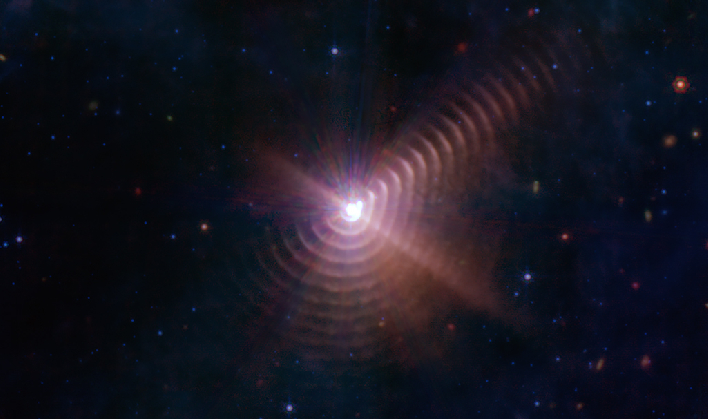JWST Captures A Wild Cosmic Fingerprint From A Rare Star Dust Trail 5,000 Light Years Away

A Wolf-Rayet star is a star born with at least 25 times the mass of our Sun that "lives fast and dies hard," and is reaching the end of its life-cycle. These types of stars will more than likely collapse and end up forming a black hole. The Wolf-Rayet burns much hotter than the younger stars around it, and generates powerful winds that push large amounts of gas into space.
According to NASA, transforming gas into dust is likened to turning flour into bread. The process needs specific conditions and ingredients. Hydrogen alone cannot form dust, however, because a Wolf-Rayet sheds so much mass, they also discharge more complex elements, such as carbon. The heavier elements cool down as they enter into space, and are then compressed where the winds from both stars meet, "like when two hands knead dough."

"We're looking at over a century of dust production from this system," stated Ryan Lau, an astronomer at NSF's NOIRLab and lead author of a new study about the system. "The image also illustrates just how sensitive this telescope is. Before, we were only able to see two dust rings, using ground-based telescopes. Now we see at least 17 of them."
Another way to look at the rings being emanated, is like rings found in the center of a tree trunk. As the stars' orbits bring them closer together about once every eight years, the dust loops mark the passage of time.
While other Wolf-Rayet systems form dust, Wolf-Rayet 140 produces a unique ring pattern due the orbit of the Wolf-Rayet star is elongated and not circular. A typical Wolf-Rayet binary will form dust constantly due to its circular orbit, however, a binary pair that has an elongated orbit only produces dust when the two are about the same distance between Earth and the Sun. This pair varies from 1.3 astronomical units (AU) at periastron to 23.9 AU at apastron—distances that range from between the solar orbits of Earth (1 AU) and Mars (1.5 AU) at closest approach to somewhere between Uranus (20 AU) and Neptune's (30 AU) orbits at their furthest reaches.
"Even though Wolf-Rayet stars are rare in our galaxy because they are short lived as far as stars go, it's possible they've been producing lots of dust throughout the history of the galaxy before they explode and/or form black holes," remarked Patrick Morris, an astrophysicist at Caltech in Pasadena, California. "I think with NASA's new space telescope we're going to learn a lot more about how these stars shape the material between stars and trigger new star formation in galaxies."

